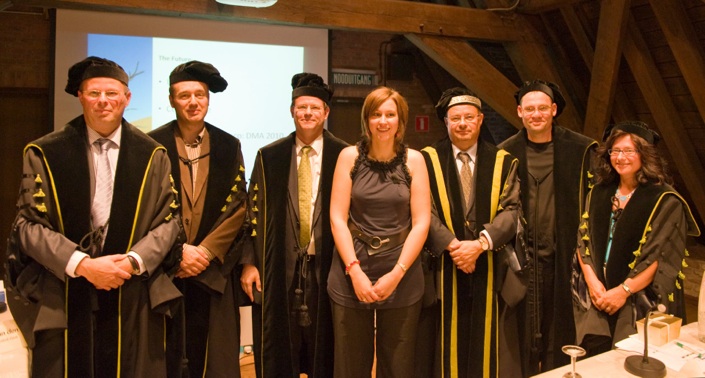Public PhD Defense by Griet Verhaert
Griet Verhaert, MMA graduate of the Class of 2005-2006, defended her PhD titled “The Role of Database Marketing in Improving Direct Mail Fundraising” (Advisor/Promotor: Prof. Dr. Dirk Van den Poel).
Griet Verhaert started her defense by giving a brief summary of her findings. Her dissertation contains four studies. In the first and second study, donation request of the solicitation letter are investigated by exploring personalized suggested donation amounts, extracted from the database, as well as the announcement of seed contributions. In the third study, we examine whether psychological measures of empathy are relevant predictors of donation behavior over and above the traditional variables. In the last study, we focus on recruiting new donors through list exchange and investigate whether it is harmful for charities to give their active addresses to other charities.
In the first and second study we focus on the content of the direct mail. Both studies are field experiments in which we explore the specific donation request in the solicitation letter. The first study investigates personalized donation amounts that are based on previous donation behavior. Charities often ask the same donation amount to all potential donors. This approach ignores that each individual may have different decision criteria and thus adaptation levels (Helson, 1964). For example, a donation request of €30 might be perceived as rather low for donors who traditionally give €60 and the same donation request might be perceived as rather high for donors who normally give €10. Based on the database of the charity, it is relatively easy to calculate a donation amount that fits within the individual’s range of acceptable donations. Previous studies have examined the influence of suggested donation amounts on consumer behavior such as donation behavior, without accounting for adaptation-level theory (Helson, 1964). As a result, we have little information on the effectiveness of different personalized suggested donations. In addition, the specific donation amount could also be complemented with social information, for example: referring to other donors who are donating. In general, consumers are often influenced by behavior of others. Hence, this study also investigates social influence as a compliance strategy to induce a person’s willingness to respond to a donation request. While previous research on social comparison in fundraising has generally focused on referring to a specific donation amount of another donor (e.g., Croson & Shang, 2008), it remains unclear whether differences in campaign success rates are due to merely mentioning that others donate or to mentioning the specific level of the donation. To map these issues, this study clearly sets suggested donation amount and social comparison apart. In sum, our first study investigates how tailoring the donation request along the donor lifecycle, in terms of suggested donation amount and social influence, could improve the campaign success rate.
Next to personalized donation amounts, the second study investigates another strategy related to the donation request: the announcement of seed money. Charities often use this strategy by showing that some funds (i.e., seed money) have already been raised in order to reach a certain threshold to realize the benefaction. Consequently, this technique mainly consists of two components: the level or percentage of seed money and the size of the threshold. Suppose that a charity needs €12.000 to start up a specific project. Here, the €12.000 is the threshold and the €5.000 reflects the seed money. Whereas previous studies investigated the role of seed money by considering one threshold (e.g., List & Lucking-Reiley, 2002; Rondeau & List, 2008), we conducted a first study that incorporates
different sizes of the threshold in combination with different levels of seed money. Moreover, the effectiveness of direct-mail campaigns may differ regarding loyalty of the customer. Because the impact of seed money across different donor segments has never been studied before, we included three different groups: prospects, low fidelity donors and high fidelity donors.
The third study is more related to target selection instead of optimizing the content of the campaign. Because the understanding of charitable giving is a crucial element in attracting and retaining private donors, we consider past behavior and socio-demographics as traditional predictor sets of charitable giving. While the first often captures recency, frequency and monetary value (i.e., RFM variables), the latter reflects, for example, features like income and age. Prior studies regularly consider intentions as good indicators of consumer behavior. This study, however, examines whether and how psychological measures of empathy can improve these traditional models of charitable giving. More specifically, the focus lies on the personality traits empathic concern and personal distress. According to Davis (1983), both constructs involve emotional dimensions of empathy and reflect distinctive feelings toward unfortunate others or oneself because empathic concern is other oriented and personal distress is self oriented. Whereas previous research often proposes empathy as an explanation for helping behavior, this study looks at the predictive power of both personality measures on top of past behavior, intentions, and socio-demographics. In particular, the study considers two distinctive aspects of charitable giving: the decision whether or not to contribute on the one hand, and the generosity of the donor (i.e., donation amount in case of donating) on the other hand. In sum, this study investigates the relevance of the above predictor sets in a real charitable fundraising setting for both dimensions.
The last study involves the exchange of addresses between charities. Charities often exchange their household lists with each other. This implicates a ‘stream of receiving’ on the one hand and a ‘stream of giving’ on the other hand. For charities related to this first stream, this exchange has two main advantages. First, while renting/purchasing addresses is very expensive, exchanging addresses avoids monetary payments. Consequently, this practice lowers the acquisition cost. Second, the fact that the charity receives a list of households who donated in the past, might indicate that these households are quite sensitive to fundraising appeals. However, next to these benefits, it remains unclear whether exchanging addresses could hurt the ‘mother’ charity. This question relates to the stream of giving and may or may not lead to missed funds. For the mother charity, it is therefore extremely relevant to understand the consequences of giving the addresses on the donation behavior of its initial donors. In other words, for these mother charities it might be interesting to discern whether external charities cannibalize their funds. Beside this general question, it might be of interest to look for specific profiles of charities which are more or less sensitive to these competitive effects.

Friday 3 September 2010

In the picture taken after the ceremony, you see (from left to right): Prof. Dr. Patrick Van Kenhove (Chair of the Department of Marketing of UGent), Prof. Dr. Arnaud De Bruyn (ESSEC, Paris), Prof. Dr. Dirk Van den Poel, “Dr.” Griet Verhaert, Prof. Dr. Marc De Clercq (Dean of the FEB, UGent), Prof. Dr. Mario Pandelaere, Prof. Dr. Maggie Geuens. Dr. Leo Paas from VU Amsterdam was unable to make it to the public defense. We would like to extend our words of gratitude to all people involved. In particular, we would like to thank Mr. Ludo Longin (DSC) for his commitment to making many of the studies possible.



The room in the historic “Het Pand” of Ghent University was packed with people.
After the ceremony, Griet had organized a nice reception...

Prof. Dr. Marc De Clercq, Dean of the Faculty of Economics and Business Administration, is chairing the exam.

